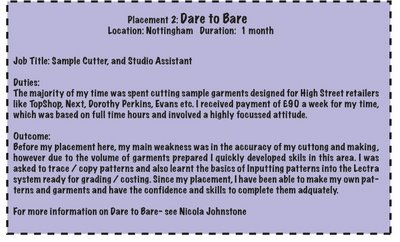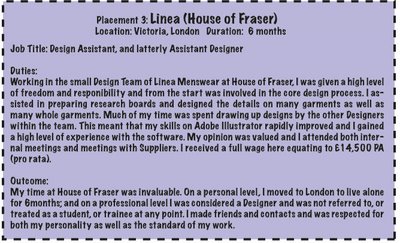
Location: “Dare to Bare”, Nottingham
Brief Description: Working mainly as a sample Cutter and general Design Room Assistant in a sample room with customers including Dorothy Perkins, Top Shop and Warehouse.
Placement Duration: 31st May – 31st June (was offered longer but declined)
Pay?: Dare to Bare paid student placements £18 a day (approx. £2.25 per hour)
Working Hours: 8.30 am-5pm (though worked longer frequently)
Monday – Friday. 30-minute lunch break
Dare to Bare was founded in Nottingham. It now has 2 offices, including one in London (Cavendish Place), which acts as the head office.
Dare to Bare make garment samples (from their own in house designers) and show these samples at meetings with their “High Street retailer” customers. If the design is bought, any required amendments are made (also in the studio) before the design is sealed with a final sample and sent to overseas manufacturers for production and distribution.
The Nottingham Office (at the time the placement took place) was responsible for 14 members of staff including one designer, 4 machinists, and 2 permanent and 1 freelance pattern cutter. In addition to this, the adjoining warehouse (responsible for sending and receiving large deliveries) employed approximately 5 members of staff. There were also 3 students working on a placement arrangement (including myself).
The company work continuously and within the studio, there is no awareness of season or collection; rather, the emphasis lies on the current (i.e. “What would Topshop buy now?”). Though seemingly separate at first, the London and Nottingham offices are very closely linked. For example the main designer in the London office works solely with the main pattern cutter in the Nottingham office. Constant telephone and e-mail communication and parcels of samples and designs delivered back and forth every evening bridge this physical distance.
Within the Nottingham studio, the samples are designed, patterns are made, garments are cut and assembled, patterns then digitised, graded and costed and finally (if successful) the product is sealed.
Whilst at Dare to Bare, my duties included;
>cutting out samples,
>copying patterns
>cutting out patterns,
>filing patterns,
>digitising patterns,
>Answering the telephone/ door
>Ordering the nightly collection (for delivery to the London office)
>Making and amending Sample Order forms (SO’s)
>Labelling and preparing swatches to send to customers
>Checking for errors on the manufactured garments
>Inputting patterns to be digitised
>distributing deliveries
During my placement I also had the opportunity to study the making process of a number of garments and receive advice on making from the skilled machinists. Fortunately, I was also able to copy a number of patterns for my own use, enabling me to practice further in all areas of the making process in my own time. My workstation was adjacent to that of the main pattern cutter in the studio (Richard Storer) who proved to be a valuable mentor during my stay, offering advice and skills where they were needed. In addition, I had the opportunity to take small swatches of fabrics, which form quite a reference collection. I have also received a vast anthology of useful contact details of representatives and companies from many areas of the industry.
The duty of cutting samples proved to my main task. This was to my advantage. Prior to my placement at Dare to Bare, my main weakness lay in cutting and making garments. In learning these areas in a professional environment, I developed my skills with much more speed and accuracy than I had before in other situations. This area itself was almost full time, with patterns of 17 or more pieces at times and the number of fabric pieces to cut sometimes in the 30s; I learnt to be fast, neat and organised (all of which were areas in the past I had found challenging) in no time.

The main customers of Dare to Bare included (at the time of the placement);
>Evans,
>Etam,
>Dorothy Perkins Maternity,
>Dorothy Perkins,
>Bay Trading,
>Topshop,
>Miss Selfridge,
>Freeman’s,
>Amelie May,
>Debenhams,
>Gap,
>Designer Room,
>Primark,
>Hennes,
>River Island
> and Envy
The company take inspiration for their designs from the high street. For example, they might be inspired by a garment in Zara or All Saints and use this to influence a design for Topshop or Dorothy Perkins. The whole process from design to sample presentation is very fast and can all be completed in a day to a day and a half if necessary. This means that the company is able to produce current designs that have been inspired by others already on sale and have them ready to present almost in an instant.
Dare to Bare have a vast list of suppliers. Their stock of fabrics hosts a variety of compositions and designs. Many of the fabrics are printed and new printed fabrics have to be sorted, have swatches taken and a showroom sample made from before they can be put into stock. Currently the company mainly work in viscose or viscose based fabrics. In addition, the stock of trims and accessories held at the studio is extensive. A phone book has been complied of the suppliers and representatives used by Dare to Bare. It is my hope that this will prove useful in the future.

Whilst on placement at Dare to Bare, the new skills learnt, though interesting were limited (for example, one of the few new skills learned was inputting a pattern to be digitalised). Instead, mainly my time was spent practising skills I already had. My knowledge of basic pattern cutting enabled me to grasp the pattern and sample cutting side of the job relatively quickly. I was able to profess my opinion on patterns and finished samples as well as join in discussions about techniques and fabrics.
My performance as a sample cutter was better than I had envisaged with my skills being constantly in demand by several members of staff throughout the period. I was also able to note errors in patterns and on the detail envelopes provided that were crucial in a number of garments being a success.
I performed each task requested of me with speed and accuracy. I reformed the system of delivering work, enabling me to further improve my performance at work.
As expected, the number of errors made in completing the technical duties was initially high but soon, my mistakes were negligible, enabling my confidence and skills to improve further.
Working for two pattern cutters meant prioritising the workload. This initially proved difficult, with new samples, samples to re-make and sealed samples to be cut as well. After a more organised system of work delivery, which prioritised the work enabling me to easily select the next duty, was established (by myself), it proved much easier to balance the workload.
My communication skills proved an asset on entry to the establishment, enabling me to comfortably converse with members of staff and allowing me to ask questions and advice about both the tasks in hand, and the industry in general without feeling awkward. This was an advantage as is meant no time was wasted settling in and that immediately I could immerse myself in technical duties in the studio.
Prior to my arrival at Dare to Bare, I had preconceptions of how I would adapt to a working environment. In reality, this was an almost seamless step, and though the atmosphere of the Dare to Bare studio is not one that in the future I aspire to work in, I was comfortable in the workplace immediately upon entry and adapted to working conditions well.
Over the month that I worked at Dare to Bare, I learnt a lot about the fashion industry. Primarily I learnt that my previous views of it had been somewhat jaded. I had assumed, perhaps naively that all designers sought inspiration for their designs from the world around them, from art, music and literature. I am now aware that at least for companies such as Dare to Bare, the creative input of the designers is almost non-existent. Rather, it seems that new designs are in fact based on old designs or at least those done by other people in other companies. I am aware that my preconceived view was fairy idealistic and unlikely, but the reality was far more extreme than I had imagined
In terms of my personal development, the area that my placement focussed on, though not an area that I have before enjoyed or excelled in, quickly became less of a challenge and in fact, since leaving Dare to Bare, has become something of a hobby. This is a break through for me personally. Now that my understanding of the technical aspects of design has improved, my creative work is enlightened by a sense of logic and comprehension; making the whole process (from designing to making) run much smoother.
What this placement has taught me about my own future is simple, I have learnt that my career will not be in a sample room, particularly one of this nature. Throughout the time that I was at Dare to Bare, my enthusiasm for the creative aspects of the industry, which has always been my drive, waned dramatically leading to a depleted respect for the industry and those who work therein.
Since leaving Dare to Bare, I have realised that both of my views of the industry, the ideal and the not-so ideal, have been incorrect. Techniques and inspiration vary from person to person and I now respect that. If methods of designing without creativity suit this company, then that only means that the company is not for me. In hindsight, this experience has taught me how valuable my passion for originality actually is. I am now aware that this is where my skill and talent lie and believe that to be a success, I need to nurture this skill whilst remaining aware that not all areas of the industry would value it.
I am grateful for the experience of working at Dare to Bare. As previously stated, the development of my skills has already proved a satisfying achievement, one, which I hope will be rewarding in the future.

*For more information on Dare to Bare, please see Nichola Johnstone in person *
NB- all images are Copyrighted and not to be reproduced or otherwise used.



















